In the dim glow of a thousand screens, a quiet revolution is unfolding. Films that once stumbled out of theaters to the sound of crickets and critics' scorn are being resurrected from the digital graveyard, finding audiences who weren't there the first time around. This isn't just about second chances—it's about how streaming platforms have fundamentally altered our relationship with failure and success in cinema.
The 2019 sci-fi epic 'Ad Astra' serves as a perfect case study. Despite starring Brad Pitt and boasting stunning visuals, the film underwhelmed at the box office, grossing just $135 million against a $100 million budget. Critics praised its ambition but questioned its commercial viability. Fast forward to 2024, and 'Ad Astra' has become one of the most-streamed films on HBO Max, with Gen Z viewers discovering its meditative qualities and philosophical depth that initially left mainstream audiences cold.
What's happening here goes beyond simple rediscovery. Streaming algorithms are creating accidental film festivals where movies that would never share a marquee are now recommended back-to-back. A viewer who enjoys 'Everything Everywhere All at Once' might be served 'The Green Knight' as their next watch, creating connections between films that have nothing in common except their algorithmic DNA. This digital curation is forming taste communities that transcend traditional demographic boundaries.
The financial implications are staggering. Studios that once wrote off underperformers are now seeing residual payments from streaming platforms that sometimes exceed theatrical returns. The 2022 fantasy 'The Northman,' which lost money during its theatrical run, has reportedly generated more revenue through streaming licenses than it did in theaters. This has created a strange new calculus where a film's ultimate success might be measured years after its release.
This phenomenon is particularly pronounced for mid-budget films—the $30-60 million productions that have become increasingly rare in theaters. Streaming services are hungry for content that feels premium without carrying blockbuster price tags, creating a new market for exactly the kind of films that theatrical distribution was abandoning. The result is a golden age for filmmakers who want to make ambitious, personal projects without the pressure of opening weekend numbers.
Audience behavior is changing too. The 'weekend watch' has replaced the 'weekend outing,' with families and friend groups collectively discovering films that they might never have risked $15 per ticket to see. This lower stakes viewing environment allows for more experimental taste-making. People are more willing to give a challenging film 20 minutes of their time at home than they were to commit to two hours in a theater.
The critical establishment is scrambling to catch up. Films that received mixed reviews upon release are being reassessed in their streaming afterlife. The 2018 thriller 'Annihilation' divided critics with its ambiguous ending but has since developed a reputation as a visionary work that was ahead of its time. This reappraisal isn't happening in film journals but in TikTok videos, YouTube essays, and podcast deep dives—a democratization of criticism that's creating alternative canons.
There's a dark side to this streaming renaissance. The same algorithms that resurrect interesting failures also bury them deeper when they don't find an audience. A film that doesn't generate engagement metrics might disappear into the digital void forever, never to be rediscovered. The sheer volume of content means that many worthy films will never get their second chance, lost in an endless scroll of options.
The relationship between filmmakers and their work is changing too. Directors who once had to mourn their films' theatrical failures can now watch them find audiences over years rather than weeks. This delayed gratification creates new creative possibilities—the knowledge that a film might find its people eventually allows for more risk-taking in the present.
What emerges from all this is a new ecosystem where success isn't binary. A film can be a theatrical disappointment, a streaming sensation, a critical reappraisal, and a cultural touchstone all at once. The traditional metrics of box office numbers and review aggregates are becoming increasingly inadequate to capture a film's true impact.
As we move further into this new paradigm, we might need to completely rethink how we measure cinematic success. The films that shape our culture might not be the ones that make the most money on opening weekend, but the ones that stick around in the collective consciousness, finding new relevance with each passing year and each new generation of viewers discovering them through the magic of digital serendipity.
The streaming paradox: why box office bombs are finding new life as cult classics

